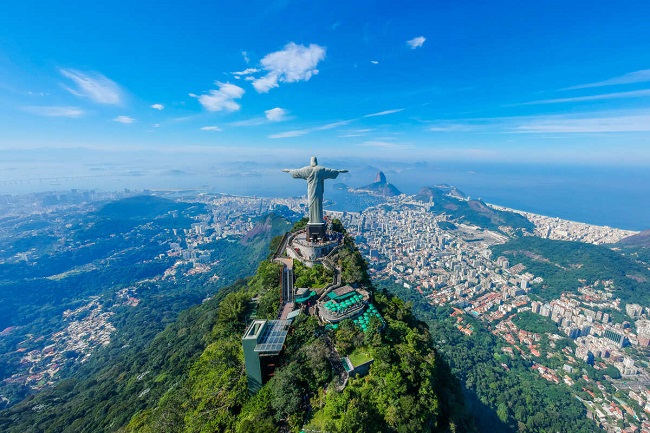Brazil is a popular tourist destination since it is home to one of the best football teams in the world, the Rio de Janeiro Carnival, and the breathtaking Iguazu Falls.
Brazil, the largest country in South America, occupies nearly the whole continent’s northeast and is bordered by every country in the region other than Chile and Ecuador.
What You Want to Know?
Top 10 Places to Visit in Brazil
Travelers to Brazil can choose from a wide variety of unique destinations, including the Amazon rainforest in the north, the Atlantic coast’s tropical beaches, the Pantanal wetlands, and the thriving metropolises of the south.

1. Brasilia
Brasilia, located in the Brazilian Highlands, became the country’s capital in 1960. The city was planned and constructed into what some call a utopia by former Brazilian president Juscelino Kubitschek in the late 1950s.
Read Also:
Modern day Brasilia’s infrastructure takes the form of an aeroplane, with separate portions serving as administrative, business, residential, and cultural areas. The modern and inventive buildings of Brasilia are a major tourist draw.
Most noteworthy is the Three Powers Plaza, which houses the Presidential Palace, the Congress and the Supreme Court. The Presidential Palace (Palácio da Alvorada) and the Television Tower (Telemóvel) are two other notable structures.
The glass dome atop Brasilia Cathedral, which looks like outstretched hands, is an architectural marvel. Brasilia is not just made out of concrete, steel, and glass; it also has a vast artificial lake and several lovely parks where people can go to relax and enjoy themselves. The capital is also an important transit hub for travel within Brazil.
2. Ouro Preto
Ouro Preto, nestled in the Minas Gerais mountains, is Brazil’s most beautiful and well-known colonial town. As it was one of the main centres of the Brazilian Gold Rush, wealth and riches poured into its streets – along with the power and prestige that came with it.
Its historic district is spread out across a series of hills, and it is characterised by narrow, steep streets lined with beautiful, historic buildings and churches dating back to the 18th century.
Ouro Preto’s mining heritage and the works of Aleijandinho’s artists are the subjects of several of the city’s fascinating museums.
People from all over the world take guided tours of the city’s many mines and explore its rich cultural history. More and more people have been flocking to Ouro Preto’s historic streets to celebrate the city’s colourful funfair in recent years.
3. Bonito
Bonito, a little community in southwestern Mato Grosso do Sul, is a fantastic base from which to explore Brazil’s breathtaking Pantanal region. The town has long been the model of environmentally responsible travel in Brazil, despite the fact that there is not much to see or do there.
The landscape around Bonito is replete with beautiful natural features, such as cascading waterfalls, rushing rivers, and enormous sinkholes and caves with lakes where you may go swimming or snorkelling.
Trekking in the lush jungle is very popular, with loads of colourful wildlife and flowers to be seen in Serra da Bodoquena National Park. Tours depart often from Bonito’s pousadas, and visitors can expect to learn a lot about the Pantanal’s many ecosystems and flora and fauna.
Blue Lake Cave is one of the largest flooded caves in the world, and snorkelling beneath the underwater stalagmites at Anhumas Abyss is another popular activity.
4. Fortaleza
Fortaleza is a renowned Brazilian tourist destination due to its attractive beaches, thriving commerce, and exciting culture. Fortaleza, capital of Ceará state on Brazil’s northeastern coast, is the country’s fifth-largest city and is famous as the birthplace of forró music.
Fortaleza has a wide variety of attractions, from colonial buildings to more modern structures. The city’s restaurants, stores, and movie theatre can be be found on the central plaza, known as Praça do Ferreira.
Another well-known plaza in which to watch street artists at work is Praça José de Alencar. Many visitors come to Fortaleza to enjoy the city’s 16 miles of urban beaches. Praia do Futuro is the most visited, but other popular beaches include Iracema, Mucuripe, and Meireles.
The beaches are fantastic places to swim, sunbathe, fish, and watch surfing competitions; they also feature lodging, dining, and shopping options. Fortaleza also acts as the jumping-off point for many travellers to absolutely stunning beaches, undulating dunes and picturesque fishing communities along the Ceará coast.
Fortaleza also draws visitors because of its fantastic shopping. Because the city is home to a significant textile sector, clothing is affordable here. The city’s markets sell a variety of locally made goods in addition to fresh seafood and veggies, while the Iguatemi Mall has something for everyone.
5. Chapada dos Veadeiros National Park
Home to glittering lakes, spectacular waterfalls, and breathtaking landscapes – as well as some of the oldest and most biodiverse tropical ecosystems in the world – Chapada dos Veadeiros really is a joy to discover.
Spanning a wide territory in the centre of Brazil, the wonderful microregion can be found in the state of Goias, some three hours drive north of the nation’s capital Brasilia.
Chapada dos Veadeiros’ main attraction is the wonderful national park of the same name that lies atop an ancient rainforest-coated plateau.
There are many breathtaking waterfalls tucked away in the park’s verdant vegetation, and exploring the park’s rugged terrain is a fascinating pastime.
Moon Valley, so named because of its lunar landscapes, is another must-see. Swimming and bathing in any one of the numerous waterfalls and rivers that dot the area is a must-do.
The two main places to stay when visiting Chapada dos Veadeiros are Alta Paraiso and Sao Jorge, a small city and village which lie not too distant from all of the key landmarks.
6. Recife
Nicknamed the “Venice of Brazil” because of its numerous waterways and bridges, Recife is the capital of the Pernambuco state and one of the largest and most important cities on Brazil’s northeastern coast.
Recife, Brazil, is a fascinating destination thanks to its historic old town, beaches, and lively culture, all of which are set against the backdrop of tropical forests and a plethora of islands and rivers.
Many colonial buildings from Recife’s time as a Dutch colony in the early 17th century can be found in the city’s historic district. The Franciscan Convent of Saint Anthony is one of the most beautiful baroque churches in Brazil and is home to the oldest synagogue in the Americas.
Historic significance and the scenic environment of colourful buildings, shops, and restaurants in Saint Peter Square are also well-known. Sao José Market is the city’s primary marketplace, where many locals go to buy fresh vegetables, medicinal plants, and unique artisanal goods.
Recife’s beaches are regarded among of the best in Brazil. Boa Viagem is the most popular beach due to its white sands, clear water, and coral reef, as well as its proximity to hotels, restaurants, and pubs.
7. Chapada Diamantina National Park
Chapada Diamantina National Park, located in the middle of the Brazilian state of Bahia in the country’s northeast, was established in 1985 to conserve, maintain, and promote the region’s breathtaking natural beauty and diverse ecosystems.
The park is a popular destination for hikers, campers, and other outdoor enthusiasts because of the variety of landscapes it offers. The park’s location atop a plateau makes it very hilly, with some peaks exceeding 2,000 metres in height.
Several spectacular waterfalls, including Brazil’s biggest, the 380-meter-tall Cachoeira da Fumaca, dot the plateau’s craggy edges. Its mountainous landscape is dotted with cavernous caves, the greatest of which are Lapa Doce and Pratinha.
Chapada Diamantina National Park’s increasing popularity can be attributed to the park’s varied landscapes and stunning scenery.
Campsites are plentiful, and hotels in nearby cities like Lencois and Vale de Capao are also an option. Swimming in the local rivers and pools, as well as horseback riding and hiking, are among popular activities.
8. Florianopolis
Florianopolis, the capital of the Brazilian state of Santa Catarina, is located in the country’s southeastern corner, with half of the city situated on the mainland and the other half on a lovely island.
It is largely regarded as one of the nicest places to live in the country, and its picturesque location is a major reason why. Modern Florianopolis is home to numerous upmarket dining and nightlife options, in addition to being a major political, cultural, and economic hub in Brazil.
Despite this, it is a charming laid-back community, with a distinct personality for each of its areas. Nonetheless, the abundance of stunning beaches is the primary draw. Florianopolis features a big lagoon, magnificent dunes, glittering waterfalls, and forested mountains — all of which make for a divine setting in which to unwind.
Popular things to do on the “Magic Island,” as it is often called, include hiking, cycling, paragliding, and water sports.
9. Manaus
Manaus, capital of the Brazilian state of Amazonas, is a major travel hub for visitors to the Amazon Basin to the north. Manaus is the largest city in Northern Brazil and was founded in the early 20th century when the rubber industry began to boom.
It is home to notable attractions like the Amazonas Opera House, the Adolpho Lisboa Market, and the Rio Negro Palace. The port of Manaus is not just the most popular departure point for river cruises into the Amazon jungle, but also a major commercial hub for various manufacturing businesses.
These excursions provide excellent opportunities to observe the Paricatuba Waterfall, the Love Cascade, and the Pied tamarin, Brazil’s most critically endangered monkey.
The Meeting of the Waters is another must-see landmark, since it is the point at which the Negro and Solimes rivers meet after flowing parallel to one another for more than three miles.
Public parks, a botanical garden, and a zoo are available in Manus, in addition to the rainforest and river. There are a number of beaches in the area, including the popular Ponta Negra, which also features a wide variety of lodging options.
Read Also:
- Top 10 Places to Visit in Dublin
- Top 10 Places to Visit in Mexico City
- Top 10 Places to Visit in Washington, D.C.
10. Rio de Janeiro
Rio de Janeiro is the most lively and interesting city in the world. Rio de Janeiro, in southeastern Brazil, has more visitors than any other South American city because of its world-famous mountains, beaches, and Carnival festival.
Famous beaches like Copacabana and Ipanema, as well as the Sugarloaf and Corcovado mountains, can be found in and around Rio de Janeiro, which is located on one of the world’s largest harbours. Tijuca National Park is one of the world’s largest urban woods, and it can be found right in the middle of this massive city.
The massive Christ the Redeemer statue atop Corcovado mountain is the city’s most recognisable landmark. The Maracan Stadium is one of the largest football stadiums in the world and one of the most recognisable landmarks in Rio de Janeiro.
Unfortunately, Rio is also well-known for its violence and slums. The favelas are slums that contrast with the more affluent portions of the city; they are typically situated on the city’s various mountain slopes.
One of the major Carnival festivities takes place in Rio de Janeiro, and it is known for its colourful parades, elaborate costumes, dancing, music, fireworks, and lively street parties. Even when the festival isn’t in town, the city’s many pubs and nightclubs keep the party going late into the night.


































